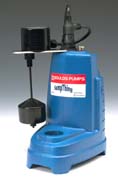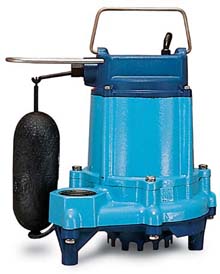
And not just any system - the trend today is bigger, heavy-duty systems with sophisticated battery back-ups and high water alarms.
“Rather than selling something you'd find at Home Depot, we're selling what we would normally put into a commercial building,” says Ryan B. Stickney, design engineer at Daugherty Sales. Typically, these are 1/3-horsepower sump pumps that pump 60 gpm at 10 starts per hour. Most residential models are rated six starts per hour.

The only problem with these larger pumps is that they need larger basins to perform properly, he explains. If the basin is too small, the system short-cycles: The water is pumped out too fast, the basin quickly fills up and the pump immediately turns on again. This can cause the pump to burn out.
“That larger basin gives homeowners more time to react and the pump more time to rest when it needs to,” he says.
Typical residential basins are 18 inches x 24 inches. Stickney recommends a 24-inch x 48-inch basin for the larger pumps. While this is easy to do when building a new home, it's much more complicated in a retrofit situation.
“There are two things that can happen,” he explains. “You can install a heavy-duty pump that can take a little more of a beating into the existing basin, which may be only 24 inches or 30 inches deep. We've seen success with that. Or you can break the concrete floor, pull out the existing basin and install a new one. That's a lot more labor-intensive at a pretty heavy cost.”

Back-Ups & Alarms
Along with the sump pump, Stickney always suggests installing a battery back-up and high water panel alarms to complete the system. Even if a home has a smaller residential pump, a battery back-up is crucial when the power goes out.“A lot of people don't know about battery back-ups - until their basement floods!” he notes. “About 20 percent of the homes we go into have some type of battery back-up system. It's the homeowner's insurance policy. If you lose power - I don't care what kind of pump you have - it's not going to work. That back-up system is imperative.”
Most of today's back-up systems are no longer DC-powered. They are inverter systems that plug into the wall, and the AC-powered pump is plugged into the inverter. Average operation is about eight hours.
Conventional DC-powered pumps are dedicated to the battery back-up, but they only work when the power fails. And how often do homes lose power long enough for the basin to fill? Batteries lose their charge over time, so when a DC-powered pump is needed, it may not have enough energy to do the job.
An inverter system automatically senses power loss. It takes power from the batteries (24V or 12V) and converts it to the 115V needed to power the sump pump.

High water alarms also are important, he adds. It tells the homeowner when his sump pump has failed, or if the water is rising too fast and the pump isn't keeping up. The local alarm has a buzzer and a light, so it's easy to hear and see when people are at home. Some also come equipped with an auto-dialer that is set to call your customer's cell phone or home phone, depending on whether he or she is at home. The unit also can be set to call you in the event your customers are out of town.
